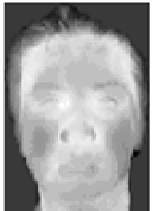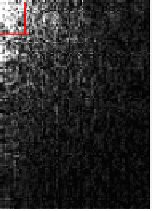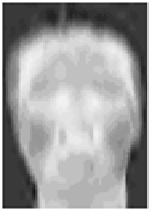Graphics Reference
In-Depth Information
(a) (b) (c)
Fig. 1.
The original map, corresponding to the DCT coefficients and the reconstructed image
using 1 / 25 of the DCT coefficients. (a) is the normalized image. (b) is DCT coefficients (c) is
the image using 1 / 25 of the DCT coefficients.
Theoretically, the number of DCT transformation coefficient equals the size of the
image, as the previous analysis indicated, it can be observed that a large amount of
information about the original image is stored in a fairly small number of coefficients
(in the upper-left comer, corresponding to the low spatial frequency components in
the image). Thus it is reasonable to take a certain amount of the DCT coefficient as a
feature vector, and preserve it in the database. In this research paper, a form of
rectangular window is used in order to preserve the DCT coefficients.
3
Partial Least Squares Classifier
In this essay, we extract and classify the features from the DCT transformation
based on Partial Least Squares (PLS) regression. PLS is a supervised learning
method that models linear relations between sets of independent variables and
response variables via an intermediate latent space [12]. PLS models the relations
between sets of observed variables by means of latent variables. In its general form,
PLS creates orthogonal score vectors by maximizing the covariance between different
variable sets [11, 14].
Let us suppose that
c
is the number of subject classes contained in the training
database and
{}
k
nc
,
1,
Gf
=
∈ℜ
dg
×
is the final gallery representation such
f
ij
j
==
k
1
c
n
≥
1
g
=
n
i
f
is a DCT based
that
are the number of samples in each class,
k
k
=
1
feature vector representing the
j
th sample in the
k
th person. Then, the training
samples
G
denote a set of predictor variables. We represent the response variables
,
1,
{}
k
nc
c
Zz
==
=
i
z
∈ℜ
as a set of indicator vectors. Where
shows the membership
ij
j
k
1
of
k
th class.
i
z
is defined as a binary vector having 1 at the
k
th index and zeros
otherwise. PLS decomposes matrices
G
and
Z
into the form [14].



Search WWH ::

Custom Search